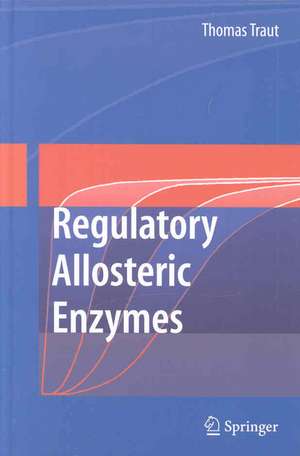Allosteric Regulatory Enzymes
Autor Thomas W. Trauten Limba Engleză Hardback – 7 noi 2007
| Toate formatele și edițiile | Preț | Express |
|---|---|---|
| Paperback (1) | 1106.45 lei 6-8 săpt. | |
| Springer Us – 4 noi 2010 | 1106.45 lei 6-8 săpt. | |
| Hardback (1) | 1110.09 lei 6-8 săpt. | |
| Springer Us – 7 noi 2007 | 1110.09 lei 6-8 săpt. |
Preț: 1110.09 lei
Preț vechi: 1353.78 lei
-18% Nou
Puncte Express: 1665
Preț estimativ în valută:
212.42€ • 222.34$ • 176.80£
212.42€ • 222.34$ • 176.80£
Carte tipărită la comandă
Livrare economică 31 martie-14 aprilie
Preluare comenzi: 021 569.72.76
Specificații
ISBN-13: 9780387728889
ISBN-10: 0387728880
Pagini: 250
Ilustrații: XIV, 250 p.
Dimensiuni: 155 x 235 x 17 mm
Greutate: 0.48 kg
Ediția:2008
Editura: Springer Us
Colecția Springer
Locul publicării:New York, NY, United States
ISBN-10: 0387728880
Pagini: 250
Ilustrații: XIV, 250 p.
Dimensiuni: 155 x 235 x 17 mm
Greutate: 0.48 kg
Ediția:2008
Editura: Springer Us
Colecția Springer
Locul publicării:New York, NY, United States
Public țintă
ResearchCuprins
Overview Of Enzymes.- To Enzymes.- The Limits For Life Define The Limits For Enzymes.- Enzyme Kinetics.- Properties And Evolution Of Allosteric Enzymes.- Kinetics Of Allosteric Enzymes.- K-Type Enzymes.- Hemoglobin.- Glycogen Phosphorylase.- Phosphofructokinase.- Ribonucleotide Reductase.- Hexokinase.- V-Type Enzymes.- To V-Type Enzymes.- G Proteins.- Protein Kinases.
Recenzii
From the reviews:
"This holistic introduction to enzymes in general covers the history of their discovery and the different mechanisms of action before going into an in-depth presentation of particular allosteric enzymes and enzyme families. … This book will be of great help to graduate students and postdoctoral fellows interested in understanding the theory behind the action of allosteric enzymes. … an excellent book of enzymology focusing on the mechanisms employed by allosteric enzymes and their metabolic regulation." (Helen Anni, Doody’s Review Service, October, 2008)
"This holistic introduction to enzymes in general covers the history of their discovery and the different mechanisms of action before going into an in-depth presentation of particular allosteric enzymes and enzyme families. … This book will be of great help to graduate students and postdoctoral fellows interested in understanding the theory behind the action of allosteric enzymes. … an excellent book of enzymology focusing on the mechanisms employed by allosteric enzymes and their metabolic regulation." (Helen Anni, Doody’s Review Service, October, 2008)
Notă biografică
Thomas Traut has a PhD in molecular biology and has studied enzymes since 1974. As a professor at the University of North Carolina at Chapel Hill, he has focused on enzyme regulation and taught advanced enzymology to graduate students. Important findings from his research helped to define the mechanism of allosteric control for dissociating enzymes.
Textul de pe ultima copertă
All enzymes are remarkable since they have the ability to increase the rate of a chemical reaction, often by more than a billion-fold. Allosteric enzymes are even more amazing because the have the additional ability to change their rate in response to cellular activators or inhibitors. This enables them to control the pathway in which they are the regulatory enzyme. Since the effector molecules represent the current status of the cell for a given metabolic pathway, this results in very responsive and balanced metabolic states, and makes it possible for cells and organisms to be appropriately dynamic, and responsive, in a changing environment. This book provides a logical introduction to the limits for enzyme function as dictated by the factors that are limits for life. This book presents a complete description of all the mechanisms used for changing enzyme acticity. Eight enzymes are used as model systems after extensive study of their mechanisms. Wherever possible, the human form of the enzyme is used to illustrate the regulatory features.
While authors often emphasize the few enzymes that have the most remarkable catalytic rates, this survery of enzymes has led to the author's appreciation of some important, general conclusions:
1. Most enzymes are not exceptionally fast; they are always good enough for their specific catalytic step.
2. Although enzymes could always be much faster if they changed so as to bind their substrates more weakly, actual enzymes must be able to discriminate in favor of their special substrate, and therefore they have sacrificed speed to obtain better binding. This means that specific control of individual metabolic steps is more important than overall speed.
3. Results for many hundreds of enzymes establish that a lower limit for a normal catalytic activity is1 s-1. Most enzymes have a catalytic rate between 10 and 300 s-1.
4. Allosteric regulation always results in a chance in the enzymes's affinity for its substrate. Even V-type enzymes (named for their large chance in catalytic velocity) always have a corresponding change in affinity for their substrate.
Thomas Traut has a PhD in molecular biology and has studied enzymes since 1974. As a professor at the University of North Carolina at Chapel Hill, he has focused on enzyme regulation and taught advanced enzymology to graduate students. Important findings from his research helped to define the mechanism of allosteric control for dissociating enzymes.
While authors often emphasize the few enzymes that have the most remarkable catalytic rates, this survery of enzymes has led to the author's appreciation of some important, general conclusions:
1. Most enzymes are not exceptionally fast; they are always good enough for their specific catalytic step.
2. Although enzymes could always be much faster if they changed so as to bind their substrates more weakly, actual enzymes must be able to discriminate in favor of their special substrate, and therefore they have sacrificed speed to obtain better binding. This means that specific control of individual metabolic steps is more important than overall speed.
3. Results for many hundreds of enzymes establish that a lower limit for a normal catalytic activity is1 s-1. Most enzymes have a catalytic rate between 10 and 300 s-1.
4. Allosteric regulation always results in a chance in the enzymes's affinity for its substrate. Even V-type enzymes (named for their large chance in catalytic velocity) always have a corresponding change in affinity for their substrate.
Thomas Traut has a PhD in molecular biology and has studied enzymes since 1974. As a professor at the University of North Carolina at Chapel Hill, he has focused on enzyme regulation and taught advanced enzymology to graduate students. Important findings from his research helped to define the mechanism of allosteric control for dissociating enzymes.
Caracteristici
Covers the most recent developments in the analysis of allosteric enzymes Extensively illustrated to clarify kinetic and regulatory properties Discusses recently created crystal structures of the enzymes Provides a detailed enzyme structure for each enzyme covered in the book Focuses on the features of these enzymes that are invaluable to the discussion of allosterism and regulation Includes supplementary material: sn.pub/extras








